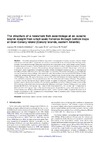Identificador persistente para citar o vincular este elemento:
https://accedacris.ulpgc.es/jspui/handle/10553/49563
| Título: | The structure of a nearshore fish assemblage at an oceanic island: Insight from small scale fisheries through bottom traps at Gran Canary Island (Canary Islands, eastern Atlantic) | Autores/as: | García-Mederos, Antonio M. Tuya, Fernando Tuset, Víctor M. |
Clasificación UNESCO: | 241705 Biología marina | Palabras clave: | Ichthyofauna Habitat Diversity Coastal fishery Atlantic Ocean |
Fecha de publicación: | 2015 | Editor/a: | 0990-7440 | Publicación seriada: | Aquatic Living Resources | Resumen: | Unsuitable management of fisheries may lead to overexploitation of marine resources. Oceanic islands with narrow continental shelves, in particular, are sensitive to unsustainable levels of fishing intensity. Fish traps are the modality of artisanal professional fishing more important in the coastal waters of the Canary Islands (eastern Atlantic) to capture demersal resources, which are deployed all year-round and allow a release of undersized captures. We aimed at studying the structure of nearshore fish assemblages through deployment of benthic bottom traps carried out at Gran Canary Island. A quantitative description of catches, in terms of abundance, biomass and sizes, of traps deployed from May to October 2009, between ca. 20 to 50 m depth, was carried out. We used this information to test whether the structure of nearshore fish assemblages at the island scale varied between three zones located at the NW, NE and E of the island with varying habitat structure. A total of 58 species (22 families) were collected for the overall study from a total of 2568 deployed traps. The species Sparisoma cretense (25% of the total biomass), the family Sparidae (16 species, 44%) and Mullus surmuletus (4%) accounted for more than 73% of the total catch in terms of biomass. The parrotfish, S. cretense, was the fish with the largest catches in terms of number of individuals, followed by Dentex gibbosus, Diplodus vulgaris, Stephanolepis hispidus, Chromis limbata and Mullus surmuletus. Differences in the structure of the fish assemblage at the island scale were not predicted by differences in the type of bottom. Fishing yields were similar between the NW (0.16 ± 0.02 kg trap-1 day-1) and NE side of the island (0.19 ± 0.01 kg trap-1 day-1), being lower at the E zone (0.15 ± 0.01 kg trap-1 day-1). The most abundant species, the parrotfish S. cretense, had a mean size close to its first maturity sizes (SFM50), while both D. gibbosus and D. vulgaris were below SFM50. In general, the mean size of Sparids was well below SFM50, an indication of overexploitation, while M. surmuletus and S. hispidus reached a mean size beyond their first maturity sizes. | URI: | https://accedacris.ulpgc.es/handle/10553/49563 | ISSN: | 0990-7440 | DOI: | 10.1051/alr/2015002 | Fuente: | Aquatic Living Resources [ISSN 0990-7440], v. 28, p. 1-10 |
| Colección: | Artículos |
Citas SCOPUSTM
17
actualizado el 08-jun-2025
Citas de WEB OF SCIENCETM
Citations
16
actualizado el 08-jun-2025
Visitas
86
actualizado el 31-ago-2024
Descargas
101
actualizado el 31-ago-2024
Google ScholarTM
Verifica
Altmetric
Comparte
Exporta metadatos
Los elementos en ULPGC accedaCRIS están protegidos por derechos de autor con todos los derechos reservados, a menos que se indique lo contrario.
